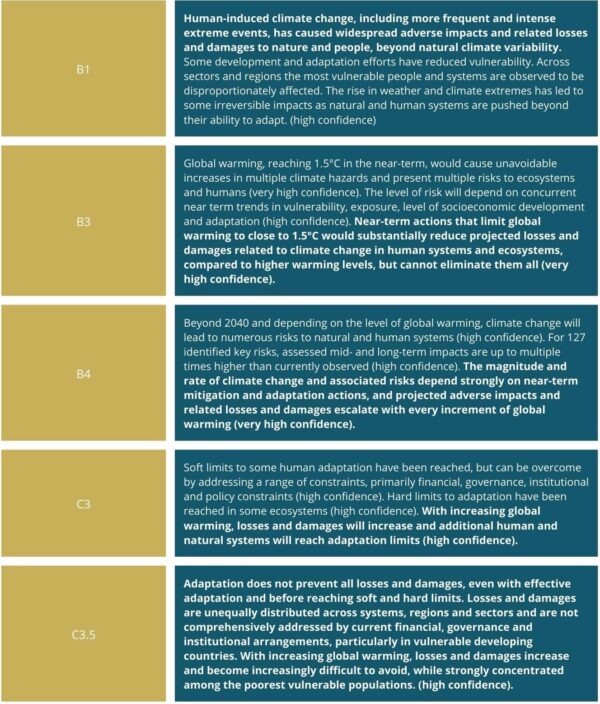What does the IPCC say on losses and damages?
Share

Note: Adelle Thomas is a lead author on the Working Group II Summary for Policymakers.
Loss and damage has been a key issue in the global climate negotiations at the UNFCCC, with developing countries – particularly small island developing states (SIDS) and least developed countries (LDCs) – being strong advocates for greater action and support to address the negative impacts of climate change.
But, including an assessment of loss and damage in the UN climate science body IPCC has been a fraught process, resulting in limited engagement with the growing scientific literature on this critical issue. While loss and damage has been referenced in previous IPCC reports, the AR6 WG II report has by far provided the most robust assessment to date.
What’s in a name? Loss and Damage vs. losses and damages
The IPCC WG II report differentiates between ‘losses and damages’ and ‘Loss and Damage’. According to its Glossary, ‘Loss and Damage’ refers to “political debate under the UNFCCC following the establishment of the Warsaw Mechanism on Loss and Damage in 2013”. The term ‘losses and damages’ refers to “harm from (observed) impacts and (projected) risks and can be economic or noneconomic.”
The use of these different terms has raised questions about how the IPCC assessment of losses and damages is related to, or can inform, UNFCCC processes on loss and damage. To address these questions, it’s helpful to underscore that the IPCC has the mandate to be policy relevant and not policy prescriptive. Providing an overview of negative impacts that are already being experienced, along with projected risks at different levels of global warming, is highly relevant to the UNFCCC negotiations on loss and damage, without prescribing particular policy approaches that should be taken.
The IPCC assessment of losses and damages provides scientific evidence of harmful impacts and risks, and highlights gaps in our current understandings of these issues. This assessment provides important inputs into the UNFCCC Warsaw Mechanism on Loss and Damage (WIM), which aims to ‘‘address loss and damage associated with impacts of climate change, including extreme events and slow onset events, in developing countries that are particularly vulnerable to the adverse effects of climate change.”
Key messages on losses and damages from the Summary for Policymakers
The Summary for Policymakers (SPM) contains a number of statements that refer to losses and damages. The key messages stemming from these statements are:
- Human-induced climate change has already caused losses and damages to both nature and people
- Losses and damages are unequally distributed across systems, regions and sectors and are not comprehensively addressed by current financial, governance and institutional arrangements, particularly in vulnerable developing countries
- Losses and damages escalate with every increment of global warming
- Near-term action that would limit global warming to 1.5°C would reduce future losses and damages but cannot eliminate them all
- Even effective adaptation cannot prevent all losses and damages
Key messages on losses and damage from WGII SPM
From the IPCC to the UNFCCC: SB56 and COP27
The need for increased support and finance for loss and damage is clear. The report finds that current financial, governance and institutional arrangements to address losses and damages are insufficient. This lends support to advocating for strong outcomes from the current negotiations on the Santiago Network and the Glasgow Dialogue, both of which aim to increase tangible support and finance for loss and damage in developing countries.
The latest science supports the ongoing advocacy from developing countries that the UNFCCC and developed countries must do much more to address loss and damage, including through providing new and additional finance.
The need for increased support and finance for loss and damage is particularly urgent given the IPCC findings that losses and damages are being experienced now, that they are projected to increase with global warming and that even effective adaptation will not be able to prevent all losses and damages.
Adaptation and mitigation are not enough to prevent losses and damages – losses and damages need separate and additional support and finance.
Second, the report underscores the critical need for ambitious and urgent mitigation efforts in order to limit global warming to 1.5°C. Exceeding 1.5°C of warming may result in some irreversible losses, such as extinction of species and the loss of ecosystems and the services that they provide. It also highlights that limits to adaptation are already experienced and that additional limits will be reached above 1.5°C.
Limiting warming to 1.5°C will substantially reduce or avert projected losses and damages, although it cannot prevent all of them. The need for more ambitious Nationally Determined Contributions that are 1.5°C compatible is clear.
Third, the report also highlights the need for increased and urgent adaptation to reduce projected losses and damages. While adaptation cannot eliminate all losses and damages, it can indeed reduce or minimise them.
The report underscores that current adaptation efforts are insufficient, that there are existing adaptation gaps and that there is a need for urgent adaptation that moves beyond incremental approaches and into transformational adaptation. Lack of finance is clearly shown to be a major constraint to adaptation and a driver of adaptation gaps. Thus, the need for increased and easily accessible finance for adaptation, particularly for SIDS and LDCs, is well supported.
There are high expectations from developing countries for SB56 and COP27 to culminate in significant progress on loss and damage, mitigation and adaptation. The findings from the IPCC WG II report support these calls and underscore the critical need for urgent and ambitious climate action on all fronts.












